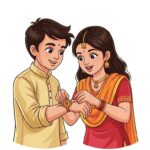Holi: Overview
Holi, popularly known as the Festival of Colors, is one of the most vibrant and widely celebrated festivals of India. It marks the arrival of spring and symbolizes the victory of good over evil, the end of winter, and the triumph of joy, love, and unity.
Holi usually falls in March, on the full moon day (Purnima) of the Hindu month of Phalguna. The festival is celebrated with colors, music, dance, and festive foods, creating a joyous atmosphere across India and among Indian communities worldwide.
History of Holi
Holi has its roots in mythology and cultural traditions:
Legend of Holika and Prahlad:
Holi commemorates the story of Prahlad, a devotee of Lord Vishnu, and Holika, the sister of demon king Hiranyakashipu.
Holika tried to kill Prahlad using her magical powers, but she was burned in the fire while Prahlad survived, symbolizing the victory of good over evil.
This legend is celebrated through the Holika Dahan bonfire on the eve of Holi.
Lord Krishna and Radha:
Holi is also associated with Lord Krishna, who played pranks by applying colors to Radha and other Gopis in Vrindavan.
This tradition has evolved into the colorful celebrations that Holi is famous for today.
Harvest Festival:
Holi coincides with the harvest season, marking the end of winter crops and the beginning of spring.
Significance of Holi
Spiritual Significance:
Symbolizes the triumph of good over evil.
Encourages forgiveness, renewal of relationships, and letting go of past grudges.
Cultural Significance:
Preserves traditional songs, dances, and folk rituals.
Encourages community bonding and social harmony.
Seasonal and Agricultural Significance:
Marks the harvest season and the onset of spring, promoting gratitude and prosperity.
Rituals and Celebrations
Holi is celebrated in two main phases:
1. Holika Dahan (Chhoti Holi)
On the eve of Holi, communities light a bonfire called Holika Dahan.
The bonfire represents the burning of evil, referencing the story of Holika and Prahlad.
People gather around the fire, perform rituals, and offer grains, coconut, and sweets to invoke blessings.
2. Rangwali Holi (Main Festival of Colors)
On the main day, people celebrate by throwing colored powders (gulal) and water at each other.
Traditional songs and dances accompany the festivities, creating a joyous and playful environment.
Friends and family come together to exchange sweets, festive foods, and greetings.
3. Foods and Sweets
Special festive foods are prepared, including:
Gujiya (sweet dumplings), mathri, thandai (milk-based drink), and papri.
These treats add to the joy and communal sharing of the festival.
Holi Across India
North India: Celebrated with colors, bonfires, and folk dances in cities like Mathura and Vrindavan.
West Bengal (Dol Jatra): Known as Dol Purnima, celebrated with swinging idols of Krishna and Radha and colored powders.
Maharashtra: Includes music, dancing, and festive foods.
South India: Celebrated more as a harvest festival, with local cultural variations.
Impact on Daily Life and Society
Community Bonding: Encourages unity, reconciliation, and social harmony.
Cultural Preservation: Keeps alive traditional music, dance, and rituals.
Spiritual Renewal: Promotes forgiveness, joy, and letting go of negativity.
Economic Activity: Boosts markets for colors, sweets, decorative items, and festive clothing.
Family and Social Joy: Strengthens relationships, family gatherings, and festive celebrations.
FAQs about Holi
When is Holi celebrated?
On the full moon day (Purnima) of Phalguna, usually in March.
Why is Holi called the Festival of Colors?
Because people play with colored powders and water, symbolizing joy, unity, and the arrival of spring.
What is Holika Dahan?
A ritual bonfire symbolizing the destruction of evil, performed on the eve of Holi.
What foods are associated with Holi?
Gujiya, thandai, mathri, and other traditional festive sweets.
Is Holi celebrated all over India?
Yes, with regional variations, but the essence of joy, colors, and unity remains universal.
Conclusion
Holi is more than just a festival—it is a celebration of life, joy, and social harmony. Through colors, music, and festive foods, it fosters forgiveness, love, and communal unity. By marking the triumph of good over evil and the arrival of spring, Holi continues to bring vibrancy, happiness, and cultural richness to India and the world.








